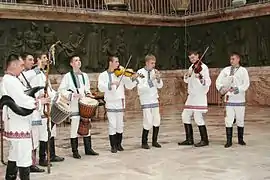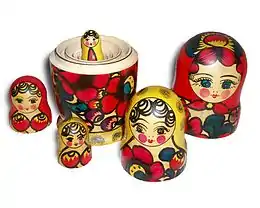Kosovorotka
A kosovorotka (Russian: косоворо́тка, IPA: [kəsəvɐˈrotkə]), commonly known in the West as a Zhivago shirt, Russian peasant shirt or Tolstoy shirt (tolstovka). The name comes from the Russian phrase kosoy vorot (косой ворот), meaning a “skewed collar”. It was worn by all peasants in Russia — men, women, and babies — in different styles for every-day and festive occasions.[1]

Description

A kosovorotka is a traditional Russian shirt, long sleeved and reaching down to the mid-thigh. The shirt is not buttoned all the way down to the hem, but has several buttons at the collar (unfastened when the garment is pulled over the wearer's head), though these are positioned off to one side (regional styles vary between left and right), instead of centrally, as is customary with a typical Western 20th and 21st century man's shirt. The side slit was to prevent cross pendants that peasants wore under their shirts from falling out when they bent down during active physical labor.[1] If left unbuttoned the collar appears skewed, which accounts for the garment's name. The collar and sleeves of kosovorotka were often decorated with a traditional embroidered ornament.[2]
The overwhelming majority of Russians were peasants, who often worked bending down towards the ground. Almost all of them wore a Christian cross, which was considered strictly an underclothing sign. The skewed collar of the shirt was designed so to prevent the cross from falling out from under the shirt. This limited annoyance and allowed for the peasant to be more productive.

The men's garment was worn loose and was not tucked into the trousers, but instead belted either with a conventional belt, a rope, or a rope-like tie. The tails of the garment hung over the trousers. Women's shirts were tucked into the skirt or worn under the sarafan, and the button line of women's shirts tended to be in the middle, rather than off at the side. Children's shirts were often too long for those who wore them, and was the only piece of clothing on little boys and girls in the ancient times.

Generally associated with Russian peasants, the kosovorotka was worn by peasants and townsmen of various social categories into the early 20th century, when it was rapidly displaced as an everyday garment by more efficient and less elaborate clothing after the Bolshevik Revolution of 1917. The garment is also known as a tolstovka, or the Tolstoy-shirt, because the writer Leo Tolstoy customarily wore one in his later years. Since the late 20th century kosovorotkas appear mostly as souvenirs and as scenic garments of Russian folk music, song and dance ensembles. The kosovorotka is also seen worn by Omar Sharif as Yuri Zhivago in David Lean's 1965 film Doctor Zhivago.
References
- Guzeva, Alexandra (September 29, 2020). "Kosovorotka: How this essential Russian shirt came about". Russia Beyond. Retrieved 1 October 2020.
- "National Russian Dress: Basic costume garments :: Manners, Customs and Traditions :: Culture & Arts :: Russia-InfoCentre". russia-ic.com. Retrieved 2018-09-10.

